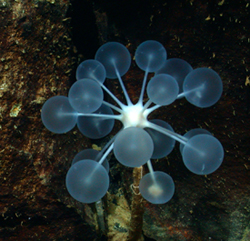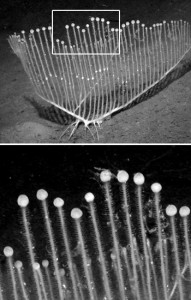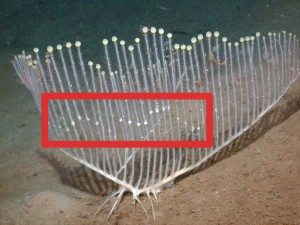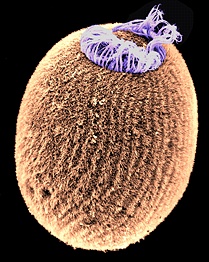Revised on Oct. 9 2017
By: Kimberly Cerilli

Chondrocladia sponge at 2555m in Gulf of California. Link
When you think of sponges the last thing that probably comes to mind is how does this squishy looking organism reproduce. However as with all areas of biology this is another unit that should be studied and discussed. Its common knowledge that sponges do not have the same set of sexual organs that humans do, however it could come as a surprise that they still do reproduce sexually. In fact most sponges reproduce both sexually and asexually. Looking specifically at the sponge Chondrocladia lyra we see a unique form of sexual reproduction. Firstly most sponges, according to Wikipedia, “produce sperm produced by choanocytes or entire choanocyte chambers that sink into the mesohyl”(3). This means that the areas that produce the male sex gametes normally sink into the main body of the sponge. In the case of the Chondrocladia lyra they have the placement of their male sex organs in a completely new spot, they are called terminal balls.

Terminal Balls: https://blogs.scientificamerican.com/running-ponies/new-carnivorous-harp-sponge-discovered-in-deep-sea/
These terminal balls develop on the ends of each arm. According to the researchers(2), these terminal balls produce condensed packets of sperm called spermatophores, which are released into the surrounding water in the hopes of fertilising other harp sponges in the area. Chondrocladia lyra are also specialised in catching sperm. While most sponges have to filter in the sperm via their water intake, Chondrocladia lyra catch the sperm with their many long arms. According to the Wikipedia page for Harp Sponges, “The harp sponge is also better at catching sperm, due to the widened stolons thoroughly lined with filaments. When the filaments snare spermatophores, they fuse with the recipient tissues. This reaction shows a swelling in the related tissues, making fertilisation evident. From these areas oogenesis occurs, followed by the maturation of the oocytes”(1). This can be summarised as Chondrocladia lyra catch the sperm coming down stream with their arms and the fertilisation process occurs directly on the arm.

Fertilized sections:
https://alchetron.com/Chondrocladia-lyra-2106588-W
In many sponge species it is common that after fertilisation the eggs stick to the sponge and grow for a period of time that is specific to that species of sponge. After a brief period of growth it is common that the eggs will hatch and the sponge will be in a larval form. Most drift on the currents and find new locations that way while others have the ability to move on their own. Once the larval lands on a secure resting point they will then attach and grow into their sedentary grownup version.

Image of a sponge larva.
https://sharon-taxonomy2009-p3.wikispaces.com/Porifera
Chondrocladia lyra are unique reproducers in the fact that they have specialised the act of sexual reproduction in ways many people thought were not possible for a ‘simple’ sponge.
Work Sited
1.https://en.wikipedia.org/wiki/Chondrocladia_lyra#Reproduction
3.https://en.wikipedia.org/wiki/Sponge#Reproduction
4.https://alchetron.com/Chondrocladia-lyra-2106588-W
6.https://sharon-taxonomy2009-p3.wikispaces.com/Porifera
7. http://www.mbari.org/scientists-discover-extraordinary-new-carnivorous-sponge/
